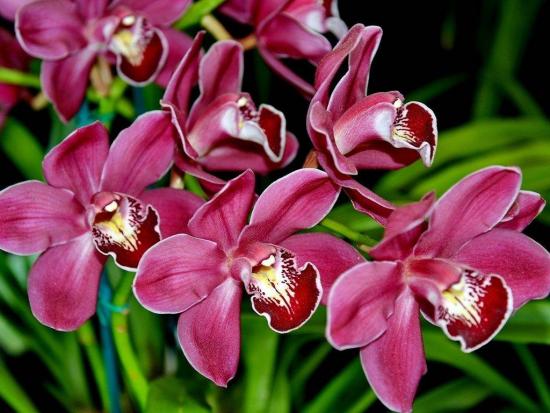Recommendations for those who want to revive an orchid at home

Despite the fact that representatives of the Orchid family are found growing wild everywhere, orchids from tropical climates are most often found in indoor floriculture. It is not uncommon for a pot of already blooming orchids to come into the house as a gift.
If you do not have the skills to care for these flowers, then most likely, inept actions can lead to the death of the flower. However, very often the owner of such an orchid has a desire to extend the life of the flower. Let's try to find out how to revive an orchid at home.
Content:
- Unpretentious types of orchids for beginners
- How to save an orchid - an epiphyte
- Treatment of terrestrial orchids
Unpretentious types of orchids for beginners
When an orchid accidentally enters the house, it is advisable to determine its species. This will help create optimal conditions for growth and flowering. It is preferable that the conditions are close to natural, in which case the orchid will live for quite a long time.
Indeed, in greenhouse farms it is not uncommon to find specimens whose age is approaching a century.
Although the word unpretentious does not quite fit orchids, if you have a choice, it is best to purchase unpretentious species and their hybrids. All orchids suitable for indoor growing can be divided into:
- for epiphytes that practically do not need soil
- for terrestrial orchids
For a beginner who is ready to learn how to care for orchids, we can recommend:
- phalaenopsis - epiphyte, the flower has many species and hybrids, you can choose according to your taste, this species can exist safely at room temperatures, requires additional lighting, phalaenopsis pleasant, pink, hybrid are suitable for indoor growing
- papheopedilum - most species are terrestrial species, some are hemiepiphytes, are resistant to low temperatures, it is recommended to choose species with one peduncle or the so-called revolving shoes
- cymbidium - predominantly terrestrial species, requires almost no special conditions, however, has low resistance to orchid diseases, for cultivation it is best to choose noticeable cymbidium, cymbidium swordifolia
All other indoor orchids can be classified as one of the listed species based on growing conditions.
How to save an orchid - an epiphyte
Of all the reasons leading to the death of the phalaenopsis orchid and similar species, two main ones can be distinguished:
- drying out of roots as a result of insufficient glaze
- rotting of roots as a result of waterlogging
Resuscitation of an orchid with dried roots
Drying of the orchid's roots as a result of infrequent watering, possibly during periods of long absence of the owners from home. In addition, the rate of moisture loss by roots is affected by low air humidity and high room temperature. If the period between watering is more than a month, and the room is dry and hot, then the roots may lose a lot of water.
If the leaves droop and some of them dry out, then urgent measures must be taken to restore the moisture of the root system. Simply abundant watering of the substrate and roots will not correct the situation in this case.A dried out root system is unable to absorb water. To revive an orchid with dried roots, you need:
- take it out of the pot
- dried leaves, cut off the peduncle
- put the plant in water
- audit the roots
- cut off dead roots that leave a hole when pressed
- dilute phytosporin, 6-7 drops per glass of water is enough
- keep the remaining roots in it for 4-5 hours
- remove the orchid and sprinkle charcoal on the wound sections
- place roots daily orchids for two hours in soft water
- keep the flower above the water for the remaining time
- spray the roots with a solution of succinic acid, three tablets per liter of water

After about 7-8 weeks, new roots should grow up to 5 cm in length. The flower can be planted in the substrate and further cared for according to the scheme. However, most often the orchid dies from rotting roots due to waterlogging.
What to do if the roots of an orchid have rotted due to waterlogging?
An orchid whose root system has not only rotted, but also separated from the leaves, can be revived in the following way:
- cut off the leaves with the neck and air dry them for several hours
- dilute any root formation stimulator and dip the lower part of the plant in it for half an hour
- dilute an activated carbon tablet in two glasses of boiled water
- lower the lower part of the orchid into water with coal
- place everything in diffused light in a warm place
- periodically wipe the leaves with a sweet solution
After two months the grown roots should reach 5-6 cm. The reanimated orchid can be moved to a pot with substrate. Perhaps at first it will be moss rather than bark.
Treatment of terrestrial orchids
In indoor floriculture, approximately 30% of all orchids are terrestrial orchids, which are grown in the ground.Most often these plants suffer from:
- from various root rots
- violations of growing conditions
- from insect pests

The most serious situation can arise in the case of root rot. To save such a terrestrial orchid you need:
- remove from the pot
- put the roots in water for an hour or two
- inspect the roots and cut off all rotten parts to healthy places
- sections can be sprinkled with antibiotics
- After this, dry the roots in air for about a day
- plant the orchid in a new pot and new soil
Despite the fact that orchids are called terrestrial, the soil in the soil for growing such orchids should not be more than 1/3 of the soil. Also, loosening and organic components should be added to it. It is most convenient to use ready-made soil.
If the orchid begins to hurt as a result of improper conditions, then the situation can be corrected by placing the pot in another place and providing the flower with the required temperature, humidity, and watering. Insects such as spider mites, aphids or scale insects can cause significant harm to the plant if the situation is left to chance.
Video on how to revive an orchid:











Comments
No matter what anyone says, orchids are quite whimsical and without special attention they wither very quickly. Sometimes I just forget to water it and as a result it dries out. Such methods really help to revive her.